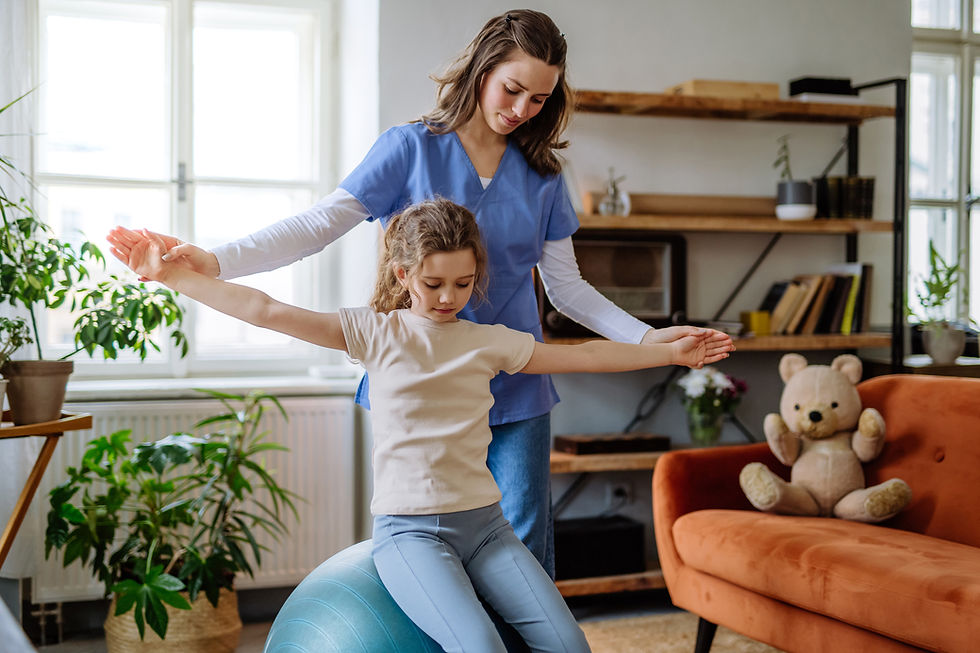Pediatric Balance Scale (PBS)
- Fysiobasen

- Sep 17
- 4 min read
The Pediatric Balance Scale (PBS) is a modified version of the Berg Balance Scale (BBS), developed to assess functional balance in school-aged children with mild to moderate motor impairments. PBS is designed to simulate daily activities that children typically perform, thereby providing a more realistic assessment of balance skills compared to traditional laboratory-based tests. The scale consists of 14 tasks related to posture changes, standing balance, and dynamic balance, each scored from 0 to 4 points. The maximum total score is 56 points, where higher scores indicate better balance function and lower fall risk¹.

Target population
PBS was primarily developed for children aged 5 to 15 years with mild to moderate motor impairments, including children with cerebral palsy (CP) or other neurological conditions. Pilot studies have shown that the test is both feasible and clinically useful in this age group¹.
Administration and method
The examiner demonstrates each task before the child performs it.
The child is allowed three trials per task to reduce the influence of learning effects or single errors.
The best performance of the three trials is recorded¹.
This approach ensures that the PBS captures the child’s maximum functional ability and reduces the impact of daily fluctuations or occasional mistakes.
Equipment
Minimal equipment is required:
Height-adjustable bench
Chair with backrest and armrests
Stopwatch or clock with second hand
Masking tape (1 inch wide)
Step stool (6 inches high)
Chalkboard eraser
Ruler or yardstick
Small level
Optional items, such as child-sized footprints, blindfolds, colorful objects (>2 inches), playing cards, or Velcro, can be used to adapt tasks when necessary².
Testing time
The average administration time is about 20 minutes², though this may vary depending on the child’s cooperation, attention span, and physical challenges.
Test items
PBS includes the following 14 tasks³:
Sit to stand
Stand to sit
Transfers between chairs
Standing unsupported
Sitting unsupported
Standing with eyes closed
Standing with feet together
Tandem stance (one foot in front of the other)
Standing on one leg
Turning 360 degrees
Turning to look behind
Picking up an object from the floor
Placing alternate feet on a stool
Reaching forward with an outstretched arm
Each task measures specific aspects of balance, including static, dynamic, and reactive balance.
Score interpretation
Total score: 0–56 points
Higher scores = better functional balance and lower fall risk⁴.
Clinical judgment is essential, as diagnostic groups and ages may show different scoring patterns⁵.
Reliability
PBS has demonstrated:
High test–retest reliability (ICC = 0.998)
High interrater reliability (ICC = 0.997)
in children aged 5–15 years with mild to moderate motor impairments¹. This confirms that the test is stable over time and consistent across examiners.
Validity
PBS has shown strong validity in different populations:
In children with spastic CP (GMFCS I–III), PBS strongly correlated with PEDI self-care (r = 0.73, p < 0.001) and mobility (r = 0.82, p < 0.001)⁶.
Another study found strong correlation with the Selective Control Assessment of Lower Extremity (r = 0.797, p < 0.05) in children with hemiplegia or diplegia⁷.
Clinical relevance
PBS is especially useful for assessing balance in children with neurological conditions. Research shows that single items, such as “standing on one leg”, explain up to 64.5% of total score variance, making PBS valuable for time-efficient screening in busy clinical settings⁸.
Sources:
Franjoine MR, Gunther JS, Taylor MJ. Pediatric balance scale: a modified version of the berg balance scale for the school-age child with mild to moderate motor impairment. Pediatr Phys Ther 2003;15(2):114-28.
Cesar GM, Giebler M, Buster TW, Burnfield JM. Balance assessment with decreased base of support for children with disabilities. Clin Exp Pediatr. 2024 Dec;67(12):718-724.
Franjoine MR, Darr N, Young B, McCoy SW, LaForme Fiss A. Examination of the effects of age, sex, and motor ability level on balance capabilities in children with cerebral palsy GMFCS levels I, II, III and typical development using the Pediatric Balance Scale. Dev Neurorehabil. 2022 Feb;25(2):115-124.
Gan SM, Tung LC, Tang YH, Wang CH. Psychometric properties of functional balance assessment in children with cerebral palsy. Neurorehabil Neural Repair. 2008 Nov-Dec;22(6):745-53.
Cesar G, Buster T, Burnfield J. Cardiorespiratory fitness, balance and walking improvements in an adolescent with cerebral palsy (GMFCS II) and autism after motor-assisted elliptical training. Eur J Physiother. 2018; 22(3): 124–32.
Chen CL, Shen IH, Chen CY, Wu CY, Liu WY, Chung CY. Validity, responsiveness, minimal detectable change, and minimal clinically important change of Pediatric Balance Scale in children with cerebral palsy. Res Dev Disabil. 2013 Mar;34(3):916-22.
Ölçek G, Çelik İ, Başoǧlu Y, Kaymakçı S, Gürlek E. Comparison of children with and without dyslexia using functional head impulse test and pediatric balance scale. Front Neurol. 2023 Jun 2;14:1153650.
Duarte Nde A, Grecco LA, Franco RC, Zanon N, Oliveira CS. Correlation between pediatric balance scale and functional test in children with cerebral palsy. J Phys Ther Sci 2014;26(6):849-53.
Lim H. Correlation between the selective control assessment of lower extremity and pediatric balance scale scores in children with spastic cerebral palsy. J Phys Ther Sci 2015;27(12):3645-49.
Narad ME, Kennelly M, Zhang N, Wade SL, Yeates KO, Taylor HG, Epstein JN, Kurowski BG. Secondary Attention-Deficit/Hyperactivity Disorder in Children and Adolescents 5 to 10 Years After Traumatic Brain Injury. JAMA Pediatr. 2018 May 1;172(5):437-43.
Craig F, Savino R, Trabacca A. A systematic review of comorbidity between cerebral palsy, autism spectrum disorders and Attention Deficit Hyperactivity Disorder. Eur J Paediatr Neurol. 2019 Jan;23(1):31-42.
Darr N, Franjoine MR, Campbell SK, Smith E. Psychometric Properties of the Pediatric Balance Scale Using Rasch Analysis. Pediatr Phys Ther. 2015 Winter;27(4):337-48.
Jantakat C, Ramrit S, Emasithi A, Siritaratiwat W. Capacity of adolescents with cerebral palsy on paediatric balance scale and Berg balance scale. Res Dev Disabil. 2015 Jan;36C:72-7.









